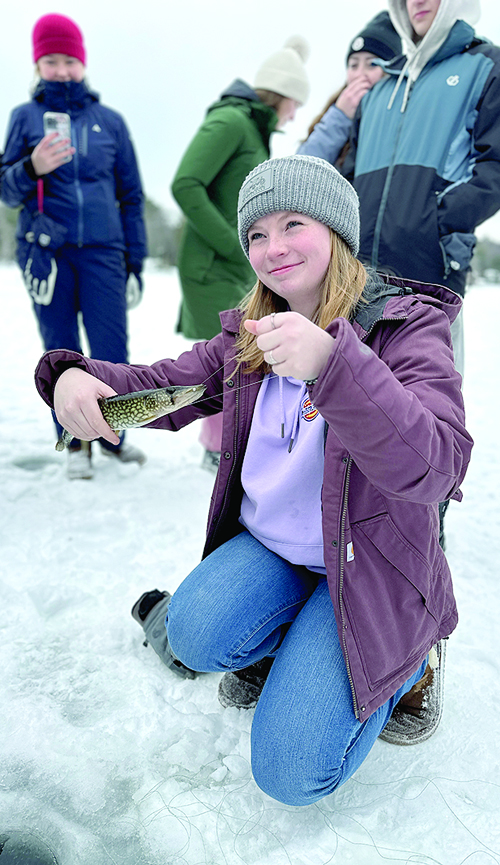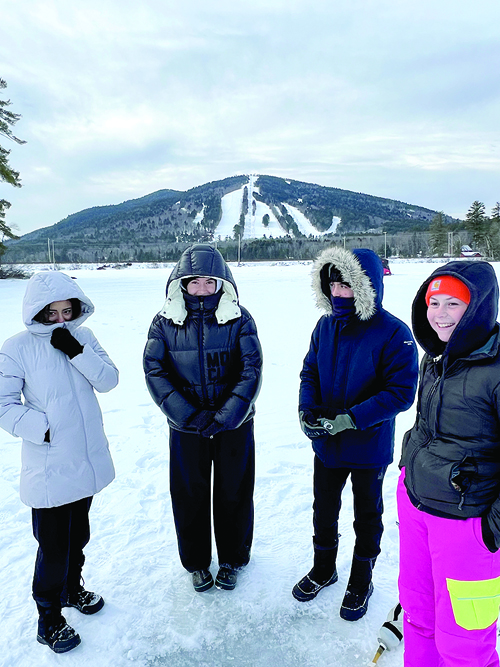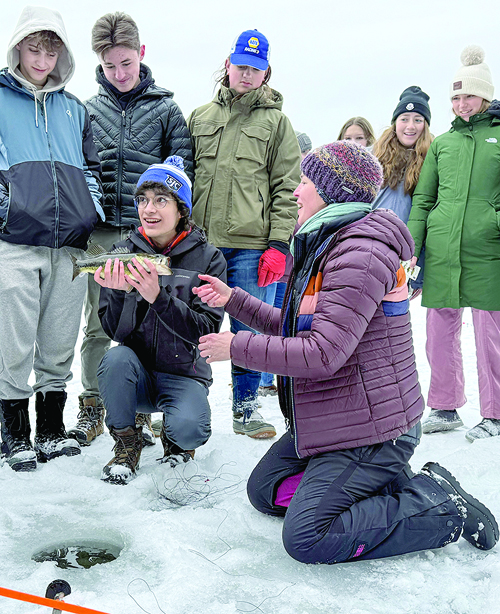Lessons from the Ice: FA students make fishing trip to Moose Pond

By Alanna Yannelli
Environmental Science Teacher
Fryeburg Academy
There are things you learn outside that just don’t translate to inside the classroom walls.
Last Friday, over 60 students from Fryeburg Academy experienced some of them on the North Basin of Moose Pond in Bridgton during an ice fishing trip.
They were joined by staff from the Lakes Environmental Association: Mary Jewett, Emlyn Emerock and Jake Linley, who oversaw stations about water testing and life under the ice.
Ruthie Clements from Sebago Clean Waters and Loon Echo Land Trust shared maps and background information about whole watershed conservation and how the watershed affects the fisheries in our ponds and lakes.
Trout Unlimited volunteers Robb Cotiaux and Jim Wescott shared their extensive knowledge about ice fishing and fish identification, while local fisherman Jason Yannelli provided traps, expertise and the popular warming hut and brought bait provided by Larry at Uncle Lunkers. What a crew! Thank you to all the organizations and people who made the day possible.

Here are some of the lessons from our ice fishing trip:
Lesson 1: Be prepared. Being outside adds another layer of challenge to learning, especially if your teeth are chattering. We experienced firsthand that spending a couple hours outside is different from walking from the bus to a classroom and learned that proper layers, gloves and footwear make a big difference for our comfort and focus.
This translates to our everyday lives; when we take care of ourselves with good food, proper sleep and fresh air and surround ourselves with good people, (when we properly prepare for each day) our brains are ready to work for us.
Conversely, we learned that it’s okay to be a little uncomfortable. In fact, our best learning is when we are a little out of our comfort zone and challenged in some way, as it allows us to truly grow. Students were rewarded their temporary discomfort on Friday by pulling seven fish out of the ice, and took great pleasure in yelling “FLAG” and sprinting to the hole.
Lesson 2: Biodiversity affects resilience. Fish in Maine undergo a series of temperature shifts and density barriers throughout the seasons, sometimes physically stuck under the ice (but safe from surface predators for a time), or stuck under the thermocline and warm water barrier in the summer.
The deeper the pond or lake, the more types of fish it can support (both warm and cold-water species). They all are adapted to undergo these seasonal changes and shift their behaviors as needed in order to survive. We will be a major part of helping these species survive shifts in summer time temperatures and oxygen levels, and our management of watersheds and development pressure will greatly impact the biodiversity of our lakes and ponds, and how well they can respond to a changing climate.

Lesson 3: Watersheds affect fisheries. Maine experiences some of the most intense development pressure in the nation, and it is vital that we connect the incredible fisheries and the Maine-way-of-life back to the forested watersheds that sustain those fisheries.
As development increases along the streams, ponds and lakes, impermeable surfaces like roofs and roads replace the filtering and shading ecosystem services of the trees. Runoff increases and the lake ecology shifts as increasing phosphorus levels and temperature and decreasing dissolved oxygen affect the water quality. Species like trout and salmon cannot survive without cold water and high dissolved oxygen levels.
We are losing our iconic cold-water fisheries across the landscape from development and warming temperatures. Thankfully, there are organizations like our local land trusts that work toward whole watershed conservation, and LEA who provide educational opportunities and monitor water quality in the area.
Maine is also fortunate to have shoreland zoning laws that protect the 250 feet of shoreline around our great ponds and rivers. This helps to reduce erosion and keep the shaded shoreline in place. We all have a role to play, big or small, in protecting our watersheds, fisheries, and way of life.
Lesson 4: Our biggest lesson: fishing is FUN. The best part of the day was seeing the students smile. Back in the classroom when we reference the yellow perch that Elise and Tony caught, or Patience’s pickerel that we left on the ice for the immature bald eagle calling to us, or the largemouth that Bryson refused to kiss, or Max’s bass redemption when he finally landed one, we can start to connect the dots from the fish they held in their hands to the warm-water fishery in the North Basin, to the water depth and dissolved oxygen measurements we took with LEA, and to the forested watershed surrounding it all. It becomes a collective experience that we can all draw on, reflect upon, and build on. And smacking a big kiss on your first fish out of the ice has a little more staying power than seeing it on a fish ID card or kahoot quiz!

